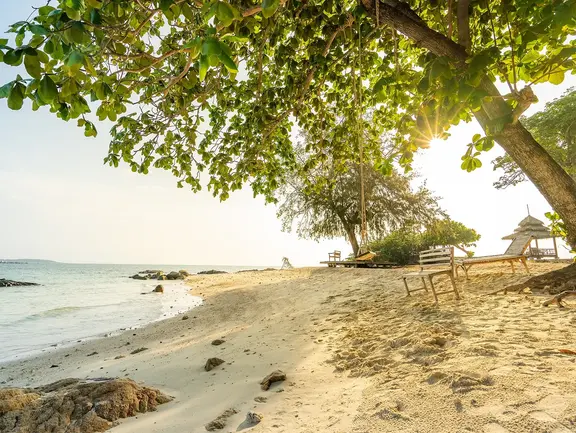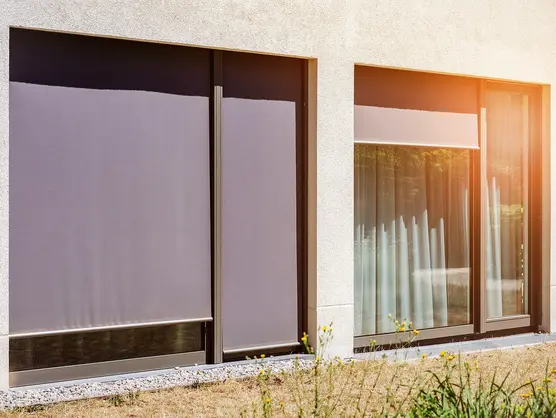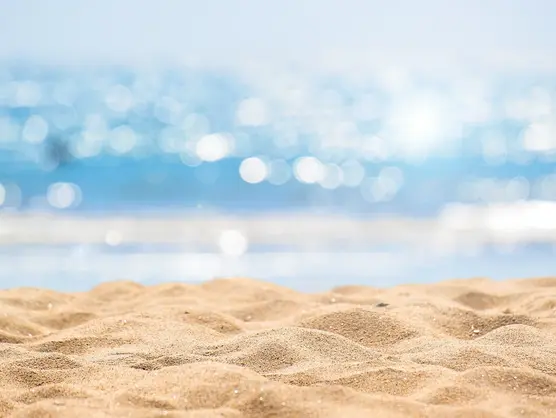Sun protection? Of course!
The sun is life, it shapes our day-night rhythm, our seasons and, due to its influence on the outside temperature, also our choice of clothing. And this is where the danger lies, because all too often we dress according to the principle: the less, the better. We only have the pleasurable things in mind, the warming rays of sunshine on our bare skin and the tan that we find so attractive and which also looks healthy. We easily overlook the fact that our skin can only tolerate a certain amount of direct sunlight and that any "too much" can leave clear marks. The most well-known side effect of careless sunbathing is the seemingly harmless sunburn.
What many people regard as a trifle can severely affect the skin and, despite its amazing ability to repair and regenerate, experience has shown that it ages much faster. In the worst case, sunburns - which are particularly common in childhood and adolescence - can develop into serious skin damage or even life-threatening skin diseases
Sunburn is caused by the proportion of UV radiation in sunlight. Sunlight is made up as follows: Ultraviolet (UV) radiation approx. 6%
- Not perceptible with our senses
Wavelength: 100-400 nm
UV radiation, in turn, is divided into
Very short-wave UV-C radiation
Penetration depth into the skin is insignificantshort-wave UV-B radiation
Penetration depth into the skin approx. 50-100µmLong-wave UV-A radiation
Penetration depth into the skin up to approx. 5 mm
Visible light approx. 50%
- Wavelength: 400-750 nm
Infrared (IR) radiation approx. 44%
- Heat radiation
- Wavelength: 780 nm -1 mm

UV-C radiation is almost completely absorbed by the ozone layer, it is not detectable in our latitudes and at best comes from artificial sources.
The short-wave UV-B radiation is absorbed by the ozone layer to 90 per cent and causes a slow, lasting tanning in the skin and the build-up of a protective layer, the so-called light callus. Negative consequences can be sunburn and, later on, skin cancer.
The long-wave UV-A radiation is hardly absorbed by the ozone layer and also penetrates deeper into the skin. It causes the skin to tan quickly, but not for long. The negative consequences are known to be light-induced skin rashes and allergic reactions (sun allergy), sunburn and, in the long term, accelerated skin ageing due to the destruction of elastic skin structures. UV-A radiation also increases the risk of skin cancer.
Prophylaxis is the be-all and end-all.
The only sensible method of reducing the risk of late sun damage is prophylaxis, i.e. preventative protection. Because once the skin is reddened, it is already too late!
Effective prevention involves responsible behaviour as well as the use of suitable sunscreens with effective filter combinations. Skin care after sunbathing is also always recommended to restore lost moisture and support regeneration. If sunburn is already present, cooling and moisturising the skin can help to alleviate the symptoms and the pain of the burn. However, acute pain relief is not an indication of the prevention of long-term damage caused by sunburn. As far as we know today, moisturising after acute sunburn cannot reverse sunburn and the resulting skin damage!
Everyone has their own individual sunburn risk!
The risk of sunburn is not the same for everyone. Pale people have a significantly higher risk than dark-skinned people, and the location and time of year also play a role in the question: How long can I stay in the sun without protection?
The skin types.
In order to determine the self-protection time and thus the personal risk of sunburn, it is helpful to categorise human skin according to skin type. The determination of skin types depends on the pigmentation of the skin; hair and eye colour are also an indication of the sensitivity of the skin. But even people with dark hair can have very light-coloured skin and therefore a high risk of sunburn!
| Definition | Most common phenotype | Protection period | |
|---|---|---|---|
| Skin type I |
- "Always" reddening - Hardly any tanning |
- Very light (white) skin, possibly freckles - Blue/blue-grey eyes - Reddish, reddish-blonde to ash-blonde hair |
10 - 20 min. |
| Skin type II |
- Often reddened - Slight tanning |
-Pale skin with a tendency to redden - Blue or green-grey eyes - Blonde to medium blonde hair |
15 - 25 min. |
| Skin type III |
- Rarely reddening - Moderate tanning |
- Light brown skin - Green and brown eyes - Blonde to dark blonde and light brown hair |
20 - 35 min. |
| Skin type IV |
- "Never" redness - Heavy tanning |
- Tan to brown skin - Brown eyes - Brown to black hair |
30 - 50 min. |
| Children's skin |
Extremely sensitive, thin horny layer, low pigmentation |
Extremely sensitive, thin horny layer, low pigmentation |
10 - 20 min. |
UV index/radiation intensity.
An individual UV radiation value can be determined for each location, which, in addition to the skin type, is decisive for the choice of sun protection. This index is an indication of the maximum daily value of sunburn-inducing solar irradiance. The scale ranges from zero to twelve. In Central Europe, the value eight is currently rarely exceeded.

This value indicates the time it takes for a certain skin type to develop sunburn. The lower the value, the lower the risk of sunburn. This results in the following recommended sun protection factors (SPF/SPF), depending on the skin type:

Active sun protection is essential!
Sunscreens help you to avoid sunburn and thus reduce your risk of developing certain types of skin cancer. The sunscreen increases your own protection time depending on your skin type as follows:
Self-protection time (in minutes) x sun protection factor = maximum time in the sun
e.g. 10 (min.) x 30 (SPF) = 300 minutes/5 hours
The generally recognised sun protection factor refers to UV-B radiation. As UV-A is also one of the risk factors, it is important that UV-A is also indicated separately on the packaging of your sunscreen. The lettering UVA in a circle indicates products that fulfil the currently valid COLIPA conditions for UV-A protection.
It all depends on the filters.
Sun protection products work through filters that protect the skin from radiation. A distinction is made between physical and chemical filters. Chemical or organic filters absorb the UV radiation and convert it into heat, while physical filters, also known as inorganic or mineral filters, reflect and scatter it
In modern sun protection products, both options are skilfully combined to achieve stable medium and high sun protection factors. Antioxidants, such as vitamin E, are also effective against oxidative skin damage. It is important to ensure that too many different ingredients do not unnecessarily increase the risk of intolerance.
Tiroler Nussöl fulfils all the conditions for optimum skin protection. Original Tiroler Nussöl products, with the traditionally used extract of the green walnut shell, contain a balanced combination of physical and dermatologically tested chemical filters in the sun milk preparations and lip protection. The Tiroler Nussöl sun oil protects against UV radiation solely through skin-friendly chemical filters.
In addition to the protective effect described above, all Tiroler Nussöl products also contribute to intensive skin care with their valuable ingredients. This keeps the skin as moisturised as possible, the skin looks firm, it feels soft and has a silky smooth sheen.
Tiroler Nussöl enables sun-seekers to enjoy the sun without any worries if they use the right product and take the recommended additional precautions!
The specified sun protection factor always refers to the correct application of the respective sun protection product. A benchmark for this is the correct amount applied to the skin. 2 mg/cm is the amount that should not be undercut in order to achieve the specified SPF. That is about three tablespoons for the body of an adult. If, for example, only 0.5 mg/cm is applied, only a quarter of the specified SPF is achieved instead of the specified SPF, which would only be a sun protection factor of 5 for a specified SPF of 20!
10 tips for sunbathing with moderation.
- Slowly acclimatise your skin to the sun. Depending on your skin type, do not expose your skin to the sun for too long!
- Stay in the shade on sunny days with a high UV index and above all avoid the midday sun between 11 a.m. and 3 p.m., which is the time with the strongest sunlight!
- Always wear headgear that also protects your forehead, nose and ears and suitable clothing that protects you from UV light when spending long periods in the sun!
- Apply sun cream to exposed areas of skin in good time before exposing them to the sun and use a suitable sun protection factor (SPF)!
- Apply sunscreen evenly and generously, as small amounts reduce protection.
- Reapply sun protection after bathing or swimming or if you have been sweating!
- Remember: Repeated application of sunscreen does not extend the time you spend in the sun. The calculated protection time may only be utilised once every 24 hours!
- Never expose small children and babies to direct sunlight. Use high sun protection factors (SPF > 25) and protective clothing.
- Medication can increase the skin's sensitivity to light or trigger allergic reactions - ask your doctor or pharmacist if you are taking medication!
- Cosmetics, deodorants or perfumes can lead to photoallergic reactions or pigmentation disorders when exposed to the sun and should therefore not be used when sunbathing.








